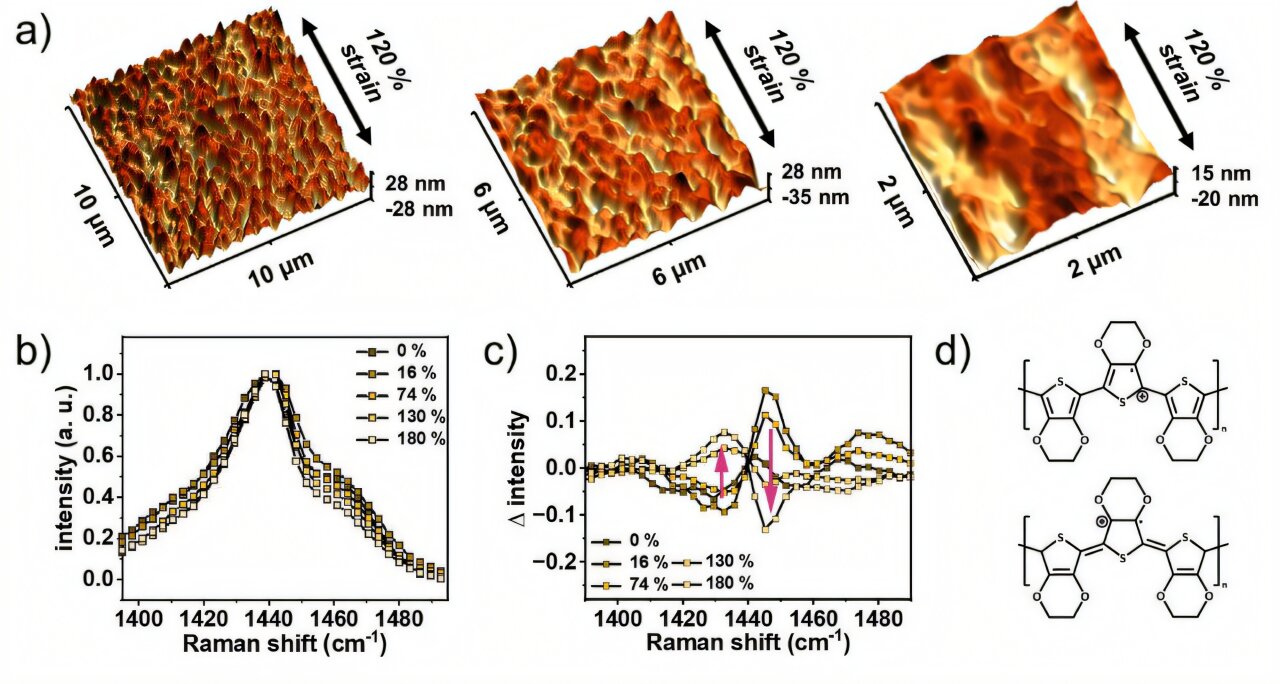
Properties of Strained Pedot: PSS Thin Films. Credit: Advanced Science (2025). Doi: 10.1002/advs.202502853
Whene aiming for stretchable, health-monitoring, skin-like sensor sheets, materials with demands are required: They need to be flexible, biocompatible, and electrically Conduccess Same time.
A research team at the max plan institute for polymer research is tackling this complex task. In a recent study, the scientists present an innovative approach: Using a transfer-printing process, the conductive polymer pedot: pss is modified via plasticizers that destruted intesto Polymer film. This significant improves bot the electrocheable conducttivity and the stretchability of the material.
The Research Results Have Been Published in the journey Advanced Science,
A Deformable Patch that Measures The Heart Rate or Detects Biomarkers in the Sweat and Feels as Soft and Flexible as One’s Own Skin – SUCH VINES Demand New Material Developments.
To realize ideas like these, as well as wearable and skin-like electronics in general, materials that positions bot high high electrical condition and mechanical stretchability is Requird.
A team of scientists at the max planck institute for polymer research LED by Dr. Ulrike kraft is currently working on this challenge. However, Stretchaability and Electrical Conducttivity are often Contradictory, Which Complicates The Development of Suitableable Materials, Explains Ulrike Kraft, Head of the Organic Bioelactronic Research Research Group.
In their current study, the researchrs demonstrate how these conflicting objectives can be overcome through the targeted transfer of plasticizers from the substrate into the pedot: pses policy: PS POSP.
Their Approach takes advantage of a transfer-printing process that enables the rapid, reliable, and straighteforward transfer of transfer of conductive polymer films onto stretchable, biaodegradeble Substrates. As a conducting polymer, the particular promising material pedot: pss is used, which combines transparency, flexibility, and biocompatibility.
“The plasticizers contained in the substrates Diffuse Into The Conductive Polymer, Thereby Improving Bot The Electrical Performance and the Mechanical Properties,” Explains Carla Volkert, doctoral Properties Student and First Author of the Study.
The approach furthermore enables fundamental insights into the behavior of stretchable electronic materials. Combining Various Analytical Methods – Including Electrical Characterization, Microscopic Imaging, Atomic Force Microscopy, and Raman Spectroscopy -The Resarchers WERECHERCE WERECHERCES WERECHERCES Into the Morphological and Electronic Changes of Pedot: PSS Under Strain.
Particularly notworthy is the observed chain alignment of the polymer chains, which results in Increased Electrical Conducttivity Under Mechanical Stress.
“Our method simultaneously improves the stretchaability and electrical conducttivity of Pedot: PSS-AAN ImpORTANT STEP Towards on-Skin Biosensors,” EXPLIKE Kraft, Bioelectronics Research Group.
This work hence not only represents an important contribution to the fundamental understanding of soft, stretchable conductive materials, but also opens up new percentes for the development of innovative Technologies – From flexible electrodes for electrocardiograms (eCGS) to stretchable biosensors on the skin that can that can detect and monitor analytes such as stress hormones in Sweat.
The next aim will be the application of this new approach for the fabrication and characterization of stretchable biosensors.
More information:
Carla Volkert et al, Enhanced Electrical Performance and Stretchability by Plasticizer -Facilitated Pedot: PSS Self -Craftsment, Advanced Science (2025). Doi: 10.1002/advs.202502853
Citation: Stretchable Electronics: Conductive Polymer optimized for wearable biosensors (2025, July 7) retrieved 7 july 2025 from https://techxplore.com/news/2025-07-stratchable-ectronics-polymer- optimized-wearable.html
This document is Subject to copyright. Apart from any Fair Dealing for the purpose of private study or research, no part may be reproduced without the written permission. The content is provided for information purposes only.



